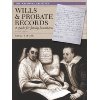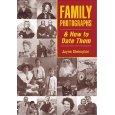

|
|
Organising and Interpreting Family History
Any serious genealogical work will lead to amassing a large volume of information, some of it amenable to computerisation but much of it in the form of raw documents such as death and marriage certificates, copies and paper ephemera. The researcher needs to think about the organisation and presentation of such material at an early stage. It is also prudent to be meticulous about recording the source of any snippet of information. You will regret it if you do not do so - believe me. And that is from someone who did not always follow his own advice.
Remember that your record system, whatever form it may take, must account for speculation and tentative guesses as well as 'verifiable facts'. We will return later to 'facts' which, in genealogical work, can often turn out to be very shaky if not misleadingly wrong.
One major consideration is that we are not only dealing with 'facts' but also probabilities. John Smith may well have been born on January 23 1857 but is this the relevant John Smith? Quite often we have to use 'working hypotheses', in scientific jargon. In other words, a supposition based on the most likely probability at a particular moment in time. Be prepared to have to change a fondly-held belief in a father and daughter or wife and husband relationship when one set of 'facts' is upset by a newer one. Genealogical research - like any other kind of research - is a fluid, changeable process.
Unfortunately, it turns out that the John Smith we have been looking for is not the one born in 1857 but his father's brother's son, also John, born three years later. Or, possibly, his grandfather's first cousin's son born in 1855. Yet another John Smith.
John and Smith are common names but experience in family history will tell you that many other names are common, both first and family. Moreover, the selection of first names seems to be remarkably unimaginative with the same set of, largely Christian, first names repeated over and over down the generations. John, James, Peter, George are just a few examples.
In fact, families often used the same names as a matter of principle, so that little George was named after his uncle George, who was himself named after HIS uncle George. Even less common surnames are associated with repeated first names: Jefferson Higginbotham may seem an uncommon combination, but not when a family has named the first born son as such for five generations.
When you realise that one family has spawned a confusing collection of individuals with repeated names, in over-lapping generations and across multiple branches, panic and disillusionment can be the result. But keep your head and persist - something sensible will emerge.
Previous page: Memorials.
 Wills and Probate Records: A Guide for Family Historians  Tracing Your Ancestors from 1066 to 1837  The Genealogist's Internet: The Essential Guide to Researching Your Family History Online  Family Photographs 1860-1945 (Public Record Office Genealogist's Guides)  Family Photographs and How to Date Them  Writing Your Family History: A Practical Guide |
Copyright © 2009-2025 Alan Price and IslandGuide.co.uk contributors. All rights reserved. Island Guide makes minimal use of cookies, including some placed to facilitate features such as Google Search. By continuing to use the site you are agreeing to the use of cookies. Learn more here